View current page
9 matchs for dorkbot:
A piece that Rick Silva showed at Dorkbot here in NY is now online: Rough Mix [Quicktime .mov] features Silva outdoors with his DJ mixing board doing turntablist moves on rocks, leaves, snow, sand, water: "scratching nature" if you will, treating the landscape as a series of imaginary vinyl LPs to be mixed. In his talk Silva discussed the importance of the hand and touch to the DJ, and here it's as if he's lost nature and is desperately (joyfully?) reconnecting with it by clawing, patting, swiping, rubbing, and scattering it. These seem like the actions of a crazy man since he has no turntables, only an unplugged board resting on various surfaces in the middle of nowhere (a gorgeous mountain landscape), but the piece makes it funny rather than alarming.
Aside from the obsessive performance aspect of it, the work thrills through its use of high-def cinematography but especially through its state-of-the-art collage of electronic sounds. One of Rough Mix's paradoxes is that turntablism is an "analog art" and the piece is about connecting with nature yet the sounds and images are quite distinctively digitally realized, that is, artificial. The abstract "music concrete" recalls urban dance music but densely filtered and "glitched"--imagine skipping CDs reverberating in a dreamy aural haze with the occasional hip hop beat cutting in and out. The timing pulls it together: the piece is long but the quick editing of the music in sync with closeups of Silva's scratching hand, spinning geosat views of the land, and the "surprise factor" of never quite knowing where the mixing board will turn up in the ecstatically empty, Western terrain, keeps you engaged. The DJ is the focal point, a crossing point of the real and the digitally mapped.
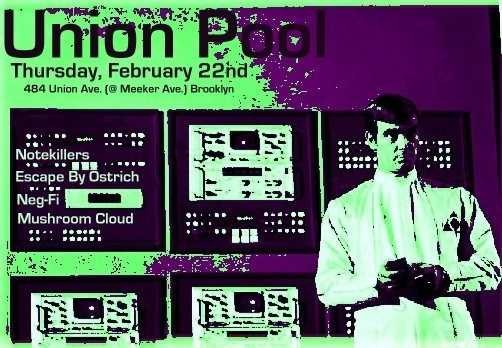
Thursday, February 22nd, 8:30pm (doors), Union Pool, 484 Union Ave (at Meeker), Brooklyn, $8
9 pm - Mushroom Cloud
9:30 - Neg-Fi
10:15 - Escape By Ostrich
11:15 - Notekillers
From Neg-Fi:
"Debut of our first LP release "Listen-OK!"- features most of the songs we've been playing as part of our live set the past few shows. Available on LP (limited edition of 200) and cdr. Also available for the first time will be a cdr collection of some older material culled from our cassette and other releases called "-1 and other big numbers."
My description of a Neg-Fi talk at Dorkbot:
"In the '50s, a time of postwar optimism and faith in science, there was Hi-Fi. In the '90s, an era of slackers and diminished expectations, there was Lo-Fi. In the '00s, a time of neanderthal government and outright contempt for the arts, there is Neg-Fi. A watershed moment in the history of art and music--some might say sub-nadir--was reached tonight when this New York noise-rock duo demonstrated its Wireless UFDs (uncontrollable feedback devices) to an audience of 100 or so at Dorkbot-NYC. Walkie talkies from the dollar store have been reinstalled in custom cardboard cases. When placed in proximity to each other and turned on, they make squealing and static noises. And that's about it!"
I've been enjoying the diverse selection of material on the Neg-Butter mini-CD--it's low-key noise rock/electronics but not unmusical by any means. (Note double negative.)
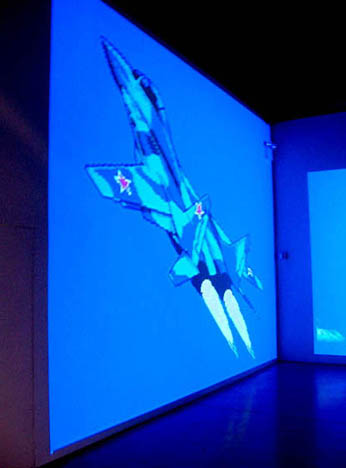
Saturday, Jan. 28 is the last day of "Breaking and Entering: Art and the Videogame" at PaceWildenstein. Planning to go later today; have held off for two reasons: (1) really more interested in videogames for the music and the visual shortcuts than thinking about them as an art movement; and (2) For blue chip PaceWildenstein, final resting place for nearly-dead canonical artists, to jump on this particular bandwagon is a bit like watching your pot-bellied, combed-over high school chemistry teacher "krumping."
But I want to see the Cory Arcangel installation above: that image looks drop dead gorgeous to me, and I can't believe the artnet reviewer's mildly sniping take on this.
The normally dynamic Cory Arcangel offers a large, static projection of a video game fighter jet and clouds to complement a primitive "found video game" displayed on a small portable laptop. Titled Bomb Iraq, the game depicts a crudely drawn bomb that the user can bring nearer to an outline of Iraq by pressing the arrow keys. Its inclusion is fine as a document of America’s meat-headed relation to the Middle East, but does nothing interesting with it -- except to prove that video games can be used as found objects just like everything else."A static projection of a video and clouds"? Hello, mural painting? James Rosenquist's F-111, maybe? And would it be worth mentioning that the laptop game, originally found on a Mac in a garage sale (see GIF below for a taste), dates to the first Gulf War? That's fifteen years of meat-headedness! Arcangel's pretty post-found object, I'd say. Is this bit of brain-damaged DIY propaganda really in the same category as the arch, Francophone disquisition of say, a Duchamp snow shovel? Perhaps, considered with the wall mural, it's actually a straight-up political statement, reportage from the frontiers of TV-addled suburbia. Maybe when I see the work I won't wonder about any of this. If I'm wrong I'll fess up.
The artnet article by Ben Davis, about current tech art, is otherwise good: it covers Dorkbot and the Superlowrez show at vertexList, in addition to "Breaking and Entering." I like what he said about the inclusive, curious spirit of Dorkbot as opposed to the regular art world's closed-mouth competitiveness (my phrasing). More about that in a later post.
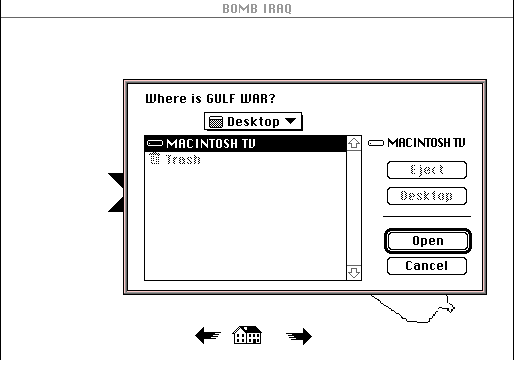
Update: Just saw the show and the Arcangel piece is definitely not "static": the clouds scroll and the jet engines shoot bitchin' flames (that move). One good thing about nearly-dead canonical artists is they generate lots of cash to throw at artist projects. Paper Rad's hyperkinetic video was especially effective in a museum-scale installation. And Jon Haddock's real-world tragedy Sims illustrations looked much better in a huge wall-sized grid than the scattering that were in the Whitney's "BitStreams" show. I was feeling kind of bad about the comb-over reference till I got to the gallery and was met at the door by a big security guard, who lurked not so discreetly while I was looking at the show. Stuffy atmosphere or what?
Update 2: Changed "rich, near-dead white guys" to "nearly-dead canonical artists" since this whole videogame art trend, at least as represented at Pace, while arguably youthful, is very white. I'm keeping the krumping reference because it captures the scene-killing absurdity of what Pace tried to do here.
In the '50s, a time of postwar optimism and faith in science, there was Hi-Fi. In the '90s, an era of slackers and diminished expectations, there was Lo-Fi. In the '00s, a time of neanderthal government and outright contempt for the arts, there is Neg-Fi. A watershed moment in the history of art and music--some might say sub-nadir--was reached tonight when this New York noise-rock duo demonstrated its Wireless UFDs (uncontrollable feedback devices) to an audience of 100 or so at Dorkbot-NYC. Walkie talkies from the dollar store have been reinstalled in custom cardboard cases. When placed in proximity to each other and turned on, they make squealing and static noises. And that's about it!
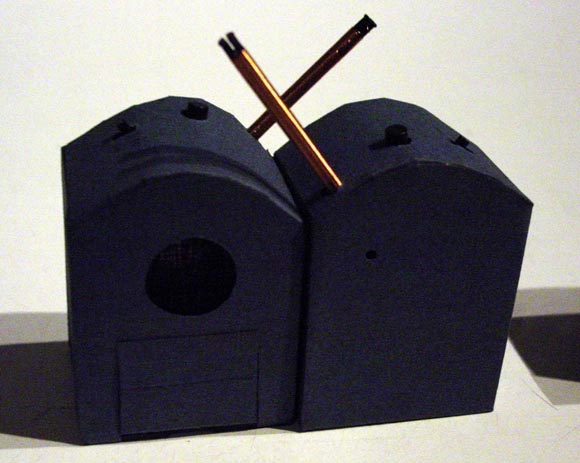
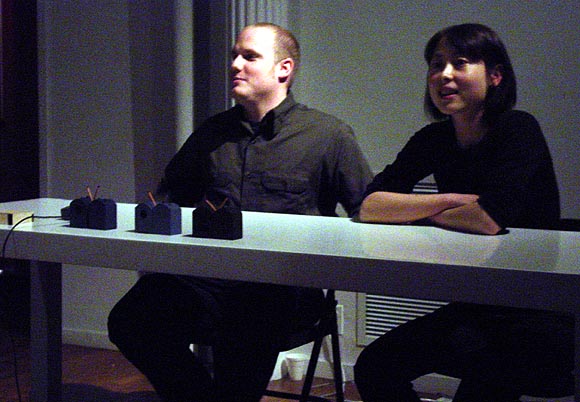
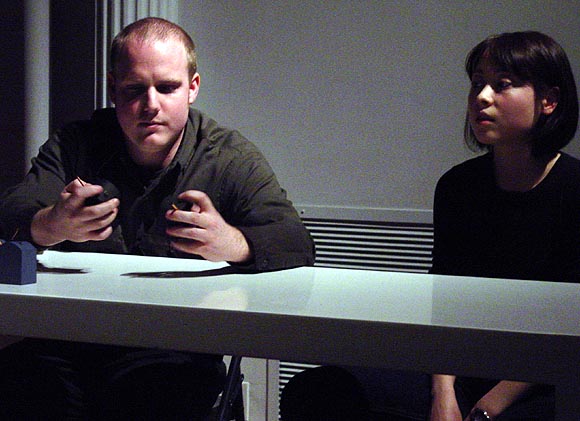
Neg-Fi's cassettes and art objects are available through La Superette, which is currently having a Valentines' Day sale. Also on the Dorkbot program tonight were Aaron Yassin, who digitally assembles plein air photos of architecture into seductive tiled patterns reminiscent of Islamic mosaics and Gothic stained glass, and Jason Freeman, who recently had a piece performed at Carnegie Hall in which an orchestra played notes based on the rate at which concertgoers turned on and off glow sticks. The somber 20th Century classical sounds made by the players, reading from a score digitally translating from the blinking lights, seemed even more sedate considering the stick-waving rave taking place in the audience.
UPDATE: The Neg-Fi photos have been brightened up. In true neg-fi spirit they lost some detail, but they are less dingy and yellow now.
A few people asked how the Dorkbot talk went on Wednesday. I'd say well. For two hours everyone swallowed their politics (incredibly, since we were all still reeling after Kerry's concession) and had a nice talk about art. My bit ran about 30 minutes, and I enjoyed my first presentation using a laptop, projector and the Internet in lieu of the old slide projector. (Unfrozen Caveman Lecturer.) Seeing my portraits, animation, and abstraction blown up that big was exciting. I wasn't happy with my answers to a couple of questions toward the end, so I'll try again here. 1. Why the molecules? A: They're the most rudimentary, ordinarily seductive kind of thing to draw on the computer. Fill in a rectangle, fill in a circle, shade. Before I was making them on the computer I was painting them in the style of a computer. They are a dumb branded art thing like a Newman stripe or a Poons dot (or a Michael Rodriguez molecule--he also paints them), that, as Johns said about flags and targets, "frees me up to operate on other levels." Maybe it's arbitrary or obvious--I don't care, I like 'em. 2. Where are the grids of found animated gifs you sometimes post? Are they art or curation? A: Boiling my art activity down to a 25-minute speech was hard. The narrative I chose was, "how I make art objects with a crappy old program and how my production eventually began to expand to include animations of the same kind of imagery as I began blogging." I had to leave a lot out, including my burgeoning music career (!), and the weird overlap of blogging, curating, and artmaking that has been a fairly constant theme on this page.
Also of note was the guy who kept asking Claire Corey pointed questions about why she makes digital paintings for gallery consumption. Why abstract expressionism, this art of the 50s? What do you get from printing it out that you don't get onscreen? Are you selling a painting or a file? The latter two questions came after Corey had explained the pains she went to to make a unique, color adjusted print on canvas, stretching it like a conventional painting so that it had scale and sensuousness and optical complexity in real space. I'm guessing the questioner was coming from some sort of conceptualist, information wants to be free frame of reference in that he seemed genuinely startled, perhaps a bit put out, that Claire was showing and selling her work in galleries. From what I've observed over the years, she gets it coming and going: the gallery world wants there to be actual paint somewhere on that canvas to legitimize it. For some reason, a digital painting pushes lots more buttons than a digitally made and printed photo. Very fertile area to be working, IMHO.
Many thanks to Douglas Repetto for inviting us to speak and making things run so smoothly. He's an awesome moderator, and it's great to see the Dorkbot empire gradually spread around the world.
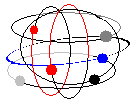 If you're in New York City, I hope you can come out tomorrow night, Wednesday, Nov. 3, for my talk at Dorkbot-NYC. Dorkbot is an informal monthly gathering devoted to theme of "people doing strange things with electricity." This month's is being held at Location One, 26 Greene Street in Soho (between Canal and Grand) from 7 to 9 pm. I've given my presentation the dramatic title "The Future of the Autonomous Art Object in a Wired World, or, How Blogging Changed My Art Life," but I'll mostly just be spieling about my artwork, while projecting some images and animated GIFs. The "virtual slides" I'll be using are posted here, minus all the illuminating chitchat. Also on the program will be Claire Corey, a digital painter I mentioned a few posts back, and Matt Hall & John Watkinson, who will be discussing their Cell Phone Drum Machine. See you there!
If you're in New York City, I hope you can come out tomorrow night, Wednesday, Nov. 3, for my talk at Dorkbot-NYC. Dorkbot is an informal monthly gathering devoted to theme of "people doing strange things with electricity." This month's is being held at Location One, 26 Greene Street in Soho (between Canal and Grand) from 7 to 9 pm. I've given my presentation the dramatic title "The Future of the Autonomous Art Object in a Wired World, or, How Blogging Changed My Art Life," but I'll mostly just be spieling about my artwork, while projecting some images and animated GIFs. The "virtual slides" I'll be using are posted here, minus all the illuminating chitchat. Also on the program will be Claire Corey, a digital painter I mentioned a few posts back, and Matt Hall & John Watkinson, who will be discussing their Cell Phone Drum Machine. See you there!Claire Corey and I will be speaking at dorkbot-nyc ("people doing strange things with electricity") on Wednesday, November 3. Matt Hall and John Watkinson are also on the program. It's the day after election day and the mood is either going to be upbeat, or...well, you know. I'll be posting notes as the event approaches, but I like this phrasing of Claire's, describing her practice as a digital painter: "This hybrid medium questions both what is expected from works made with a computer as well as what constitutes painting." I've been thinking something along those lines in connection Jason Salavon's "100,000 Abstract Paintings," AKA Golem, where he wrote a software program that encoded parameters (size of brushstroke, color, etc) but also painterly qualities derived from studying the moves of Diebenkorn, Richter, and others. There is a dual critique there. What do we expect the computer to be able to do for us? Assemble cars? Play chess? Paint? Which tasks are necessarily "automatable" and which shouldn't be delegated? But also, what are attributes constituting "good painting" these days? If they're so quantifiable a machine can recreate them, are they really "good"? The critique is more obvious and pointed if you're talking about actually writing a program that does this (and I've seen Salavon's paintings and they're actually pretty "good") but it also applies to those of us just using the machine to make paintings: Claire, me, Millree Hughes... A curated show setting out these issues would be enormously helpful.
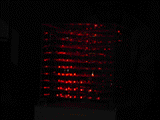 Last night at Dorkbot NY, the informal monthly gathering subtitled "People Doing Strange Things with Electricity," three people gave presentations. Left is my accidental .GIF (I thought I was making an MPEG movie) of James Clar's 3D Display Cube, a device that uses a hideous amount of computing power to render charmingly lowtech 3-D moving sculptures on 1000 LED lights in a 2 foot cube. Think 3D Jim Campbell. Mary Flanagan projected complex abstract patterns generated from the phonemes and word choices of a several month run of
emails between her collaborator Andrew Gerngross and his ex-girlfriend. It was unclear whether the, um, relationship between the data and the display was purely aesthetic, or if there were other connections or conclusions to be drawn. Fang-Yu (Frank) Lin gave a crisp power point talk on "channeling the internet though a robotic typewriter." His artwork was exactly as described: a clunky hybrid of an old manual keyboard and a teletype machine, which acts a kind of spirit medium, bringing you messages from "the internet," a quasi-mystical entity. You type in a question or statement, and hidden hardware and software search for words (in chatboards, blogs, news stories) that might logically or literally follow from what you wrote. Of course, the result--lines of text or ASCII pictures spit out of the teletype--are usually tangential (at best) to your request. Lin uses a hybrid search engine to pull up content, but casts a narrow net, apparently grabbing the first thing remotely connected to your search. The piece was almost aggressively dumb, and retro, and pseudoscientific, a kind of satirical antidote to the globalist, futurist slogans routinely bandied about by tech companies and new media visionaries (cf. Maciej Wisniewski's netomat). I immediately thought of Scott Bukatman's essay "Gibson's Typewriter," which considers the global information sea change through the metaphor of William Gibson banging out Neuromancer on a manual typewriter. Lin's presentation echoed one of Bukatman's themes--that mechanical writing was an earlier and no less earth-shaking "information revolution." The fixation on the typewriter is also in sync with current trends such as whipping out giant old cell phones purchased on Ebay to impress potential dates.
Last night at Dorkbot NY, the informal monthly gathering subtitled "People Doing Strange Things with Electricity," three people gave presentations. Left is my accidental .GIF (I thought I was making an MPEG movie) of James Clar's 3D Display Cube, a device that uses a hideous amount of computing power to render charmingly lowtech 3-D moving sculptures on 1000 LED lights in a 2 foot cube. Think 3D Jim Campbell. Mary Flanagan projected complex abstract patterns generated from the phonemes and word choices of a several month run of
emails between her collaborator Andrew Gerngross and his ex-girlfriend. It was unclear whether the, um, relationship between the data and the display was purely aesthetic, or if there were other connections or conclusions to be drawn. Fang-Yu (Frank) Lin gave a crisp power point talk on "channeling the internet though a robotic typewriter." His artwork was exactly as described: a clunky hybrid of an old manual keyboard and a teletype machine, which acts a kind of spirit medium, bringing you messages from "the internet," a quasi-mystical entity. You type in a question or statement, and hidden hardware and software search for words (in chatboards, blogs, news stories) that might logically or literally follow from what you wrote. Of course, the result--lines of text or ASCII pictures spit out of the teletype--are usually tangential (at best) to your request. Lin uses a hybrid search engine to pull up content, but casts a narrow net, apparently grabbing the first thing remotely connected to your search. The piece was almost aggressively dumb, and retro, and pseudoscientific, a kind of satirical antidote to the globalist, futurist slogans routinely bandied about by tech companies and new media visionaries (cf. Maciej Wisniewski's netomat). I immediately thought of Scott Bukatman's essay "Gibson's Typewriter," which considers the global information sea change through the metaphor of William Gibson banging out Neuromancer on a manual typewriter. Lin's presentation echoed one of Bukatman's themes--that mechanical writing was an earlier and no less earth-shaking "information revolution." The fixation on the typewriter is also in sync with current trends such as whipping out giant old cell phones purchased on Ebay to impress potential dates. I've decided to follow Cory Arcangel around on the lecture circuit (not really, but this was the second talk of his I attended this week). Last night he spoke at Dorkbot-NYC, a once a month gathering that meets at Columbia U's Computer Music Center. The theme of these events is "people doing strange things with electricity." Dafna Naphtali and Liubo Borissov also gave talks. (Photos of the event are here. On the top row, Cory is the third picture, in cap and sneakers; that's me in the second pic, holding a cup.) After the speakers I was privileged to see an amazing sight, a shrine before which all electronic music fans should bow in reverence: the original synthesizer, a pre-Moog (1950s) phalanx of hardware built by RCA that literally fills a room. It's a staggering, rack mounted monolith of vintage knobs, toggle switches, patch cords, and vacuum tubes, with keypunch equipment (to enter the music score) resembling manual typewriters holding rolls of player piano paper. The behemoth hasn't been fired up in about 10 years, but it is a thing of beauty.
What follows is something I rarely do, which is dump a bunch of raw notes on the lectures. I'll be reshaping these into an argument eventually. In a nutshell, Arcangel rejects current pre packaged software and makes art at the most basic level by getting inside a Nintendo cartidge and reprogramming it; the other two artists use state of the art digital tools taken straight off the shelf, either alone or in combination with other software. Either can be valid ways of working but in this instance I prefer Arcangel's end results. Because he's a good artist, NOT because he can program.
Cory Arcangel
video game systems - first proprietary code
6502 chip is key: runs atari, commodore 64, early apple
beige recording artists (arcangel, davis, bonn, beuckman) discover it also runs nintendo games
makes political, aesthetic sense to work on that level (reprogramming chips)
you don't rely on proprietary code
you don't rely on libraries
study of the limitations of the system
learned how to crack them thru "lots of emails to swedish kids"
mario bros. - earliest, crudest nintendo game
arcangel uses EEPROM (electrically erasable programmable read-only memory) chip burner - like cd burner - to make modifications to chip
used by "home electronics nuts"
shows ambient video of mario clouds: "that's kind of like the new style"
"actual factory-soldered mario clouds"
"not a copyright violation because not a copy"
it's important to do things down in machine language
assembly language is simple: "if______/then_______"
easier than java
audience member: "so what you're saying is, you don't have to know as much, you just have to do more work"
(UPDATE: I asked Cory by email how assembly language differed from development language (see below); he replied: "Well to put it most simply, one does not have any 'objects,' or routines to inherit from. On a new computer programming language you can usually write something like 'draw red pixel at 10 pixels down and 20 pixels across on the monitor,' and it will appear. In assembly language you have machine level access to the computer therefore you have to actually write the code that will place that pixel there because aside from routines built into the hardware, you are not forced to inherit code from other people. So on a Nintendo you have to wait for the electron beam to jump to the top of the screen [happens 60 times a second], and then put values in certain registers. Then in the brief period that this electron beam is jumping you can draw some sprites to the screen at the values you poked into the microprocessor. I like it because once you get down to looking out for the TV's electron beam, you know you are getting some low level access to the idea of 'video.'")
for super mario bros clouds piece, Arcangel used text editor to identify specific clouds
i shot andy warhol based on hogan's alley
less popular shoot em up game - "pre duck hunt"
cartridge has 2 chips - one for operating system, one for graphics
couldn't do it all in graphics; hogan characters were symmetrical and andy was asymmetrical so had to go into os to find mirroring (UPDATE: Super Mario clouds and Andy Warhol are diffferent types of hacks, per Arcangel: "[Andy] is a hack of the graphics chip
although I also had to modify the program chip a little bit because I had to change the colors, and also flip some graphics around because my new characters were asymmetrical. Clouds is just a program chip hack.")
to write the code for the chip, Arcangel uses a 6502 assembler running on a mac; the assembler's code is MPW (Macintosh Programmer's Workshop), a game development language, which runs on top of unix (UPDATE from Cory by email: "An assembler is a program that takes assembly language
[which is a kind of short hand] and turns it into machine code [which can be burned onto a chip]. My assembler happens to be a port of an old UNIX program that runs under MPW on a Macintosh. There are many different assemblers for many different platforms so the idea of it being MPW and from UNIX does not really matter. Sometimes I use an assembler that runs on DOS, and NOW I use one that runs on OSX called nesasm. Usually I would not get into that, but I suppose someone asked me a question and I had to explain exactly what I was using... Actually now I am trying to not use an assembler at all and just write the compiled machine code by hand in 1s and 0s. Just for a challenge. This is because Joe Beuckman and I kinda came up with the idea to be a
real BEIGE members one has to write in 1s and 0s.")
cartridge hacks done in rom, then tested in emulator (UPDATE: as Cory explained later by email: "an emulator is another piece of software that runs a compiled
program for the system it is emulating. They are mainly used so people can play games they grew up on, using modern computers. So for example with a Nintendo emulator, I can play super mario brothers on my MAC." His preferred one is RockNES)
"harder to reverse engineer than engineer" - one audience member takes issue
other project: collaboration with paper rad (Providence RI collective)
telling story with projection in background
(like puppet show?) no, 8-bit version of machinima
one more project: rave videos
writing programs with the mario software (demonstrates blinking geometric grids made from changing background colors - a high speed, better version of jeremy blake's early grids imho) taking advantage of mario's ability to sync up with the tv raster at 60 lines per second refresh rate, which is twice as fast as video (32 lines per second)
tag line: "twice the psychedelia"
audience member: will you ever work with game boys?
"game boy irks me"
Dafna Naphtali
"higher end audio"
uses MAXMSP music software
performance oriented
processing audio live
digital chamber-punk ensemble
Liubo Borissov
video synthesis from music
"making fire dance"
synthesized tabla drum - jerkily "dancing" flames (i did not like this - too new age)
music program used: reactor - modular synthesizer like maxmsp
edits "standard fire synthesis effect" in aftereffects, using parameters based on sound.
"communication" - looks like advanced early 90s rave video
ballet dancer with superimposed abstract painting
uses poser program for video of dancer
poser creates transitions between one pose (motion capture) and another
traces of shadow of dancer correspond to sound data
uses studio artist paint program for blue painting overlaying dancer
g-force moderates between studio artist and sound
poser option: "render as painting"
example of mapping sound to image: bass to physical size
